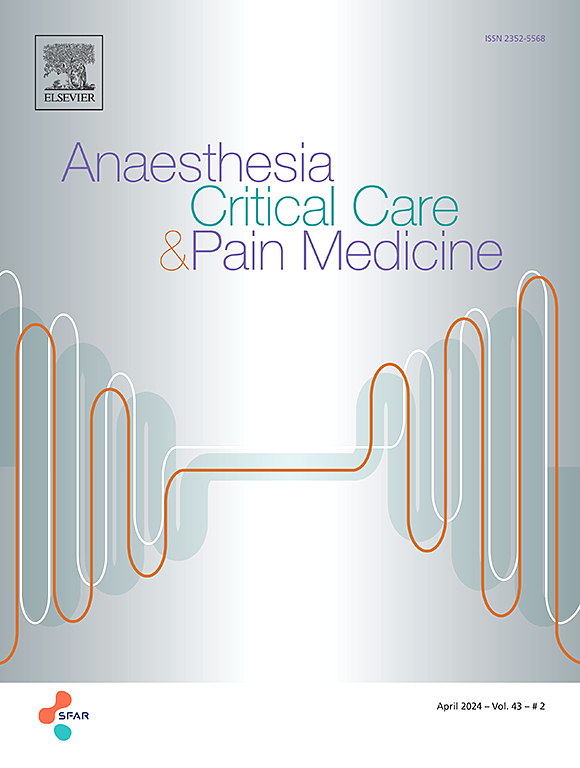Cirrhosis is an independent risk factor for candidemia in critically ill patients: A 6-year single-center observational study
IF 4.7
3区 医学
Q1 ANESTHESIOLOGY
引用次数: 0
Abstract
Background
Candidemia is a significant threat in intensive care units (ICUs), particularly for patients with cirrhosis, who appear to have a higher prevalence. No prior study has demonstrated cirrhosis as an independent risk factor for candidemia. This study aimed to investigate the risk factors and mortality associated with candidemia in ICUs, focusing on patients with cirrhosis.
Methods
We conducted a retrospective observational study over a 6-year period in an ICU with a high volume of patients with cirrhosis. We consecutively included 1985 patients, of whom 416 had cirrhosis. Among them, 37 developed candidemia, including 16 with cirrhosis. We analyzed the risk factors for candidemia in the total population and patients with cirrhosis.
Results
We identified cirrhosis as an independent risk factor for candidemia in the ICU (OR 2.28 [1.14–4.53], p = 0.019) in the total population admitted to the ICU. Among patients with cirrhosis, a high Child–Pugh score remained the sole independent correlate of candidemia (OR 1.68 [1.10–2.67]; p = 0.021). Post hoc acute on chronic liver failure (ACLF) analysis showed significantly lower candidemia-free survival in ACLF grade 2–3 versus 0–1 (log-rank, p = 0.029). Candidemia was associated with higher ICU mortality rates in both the total population (59.5%) and in patients with cirrhosis (81.2%).
Conclusion
Cirrhosis emerged as an independent risk factor for candidemia in the ICU. Within the cirrhotic subgroup, a high Child–Pugh score emerged as the sole independent correlate.
肝硬化是危重患者念珠菌病的独立危险因素:一项为期6年的单中心观察性研究
背景:念珠菌是重症监护病房(icu)的一个重要威胁,特别是对于肝硬化患者,其患病率似乎更高。之前没有研究表明肝硬化是念珠菌病的独立危险因素。本研究旨在探讨icu中念珠菌病的相关危险因素和死亡率,重点关注肝硬化患者。方法:我们在ICU中对大量肝硬化患者进行了为期6年的回顾性观察研究。我们连续纳入1985例患者,其中416例患有肝硬化。其中念珠菌37例,肝硬化16例。我们分析了总体人群和肝硬化患者中念珠菌的危险因素。结果:我们确定肝硬化是ICU住院患者中念珠菌病的独立危险因素(OR 2.28 [1.14-4.53], p = 0.019)。在肝硬化患者中,高Child-Pugh评分仍然是念珠菌血症的唯一独立相关因素(OR 1.68 [1.10-2.67]; p = 0.021)。事后急性对慢性肝衰竭(ACLF)分析显示,ACLF 2-3级患者的无念珠菌生存期明显低于0-1级患者(log-rank, p = 0.029)。念珠菌与总体人群(59.5%)和肝硬化患者(81.2%)较高的ICU死亡率相关。结论:肝硬化是ICU中念珠菌病的独立危险因素。在肝硬化亚组中,Child-Pugh评分高是唯一独立的相关因素。
本文章由计算机程序翻译,如有差异,请以英文原文为准。
求助全文
约1分钟内获得全文
求助全文
来源期刊

Anaesthesia Critical Care & Pain Medicine
ANESTHESIOLOGY-
CiteScore
6.70
自引率
5.50%
发文量
150
审稿时长
18 days
期刊介绍:
Anaesthesia, Critical Care & Pain Medicine (formerly Annales Françaises d''Anesthésie et de Réanimation) publishes in English the highest quality original material, both scientific and clinical, on all aspects of anaesthesia, critical care & pain medicine.
 求助内容:
求助内容: 应助结果提醒方式:
应助结果提醒方式:


